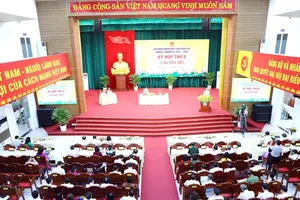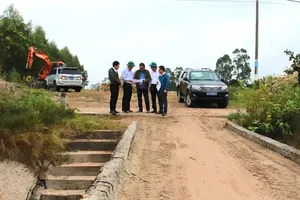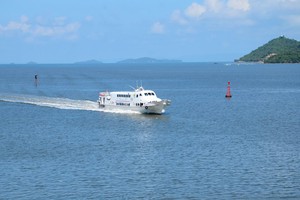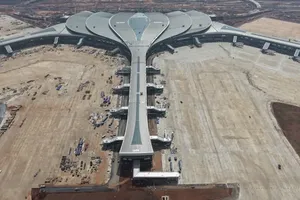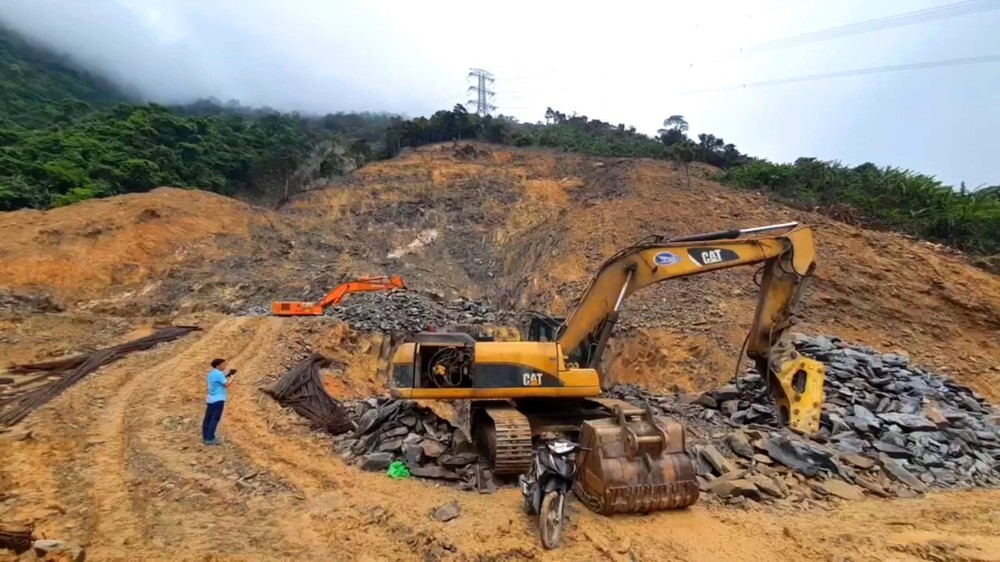
Landslides have swept through many areas, causing damage to a large area of crops, and houses, and even taking the lives of many local residents.
In the rainy season of 2023, Dak Nong Province was continuously witnessing subsidence and landslides. The province has declared an emergency for four landslide sites including the Dak N'Ting reservoir in Quang Son Commune of Dak G'long District. This project has many cracks after the rains in August 2023, with the risk of 1.2 million cubic meters of water rushing down to the downstream area, ready to flatten houses and crops. These days, the visible cracks around the Dak N'Ting reservoir have not been repaired, causing people to live in fear.
Resident Vi Van Toan in Quang Son Commune of Dak G'long District said that his family has more than 1 hectare of production land near the Dak N'Ting reservoir, so he is very worried about the subsidence. He moaned that every time it rains, the family members go around the garden to check if the landslides have sunk into the land of the house to have a plan to relocate.
According to the Department of Agriculture and Rural Development of Dak Nong Province, the provincial People's Committee has invited consulting units and established an investigation team to study the cause of the rainfall-induced landslide at the Dak N'Ting reservoir. Consulting units and the investigation team will propose solutions to repair the incident. Also on the Ho Chi Minh Road is a landslide at the section through residential group 9 in Nghia Thanh ward in Gia Nghia City of Dak Nong Province with a length of tens of meters. This location has been fenced with iron sheets to limit vehicle drivers passing through.
According to local inhabitants, the landslide appeared here since August 2023, when storms hit. However, until now, there has only been a temporary fence, not a thorough treatment. At the scene, there are dozens of households living with danger hanging around.
Chief Nguyen Tien Tung of the Office of the Gia Nghia City People's Committee said that the city has proposed to the Provincial People's Committee to arrange resettlement for households in the above mentioned landslide-prone areas, but they are currently not relocated.
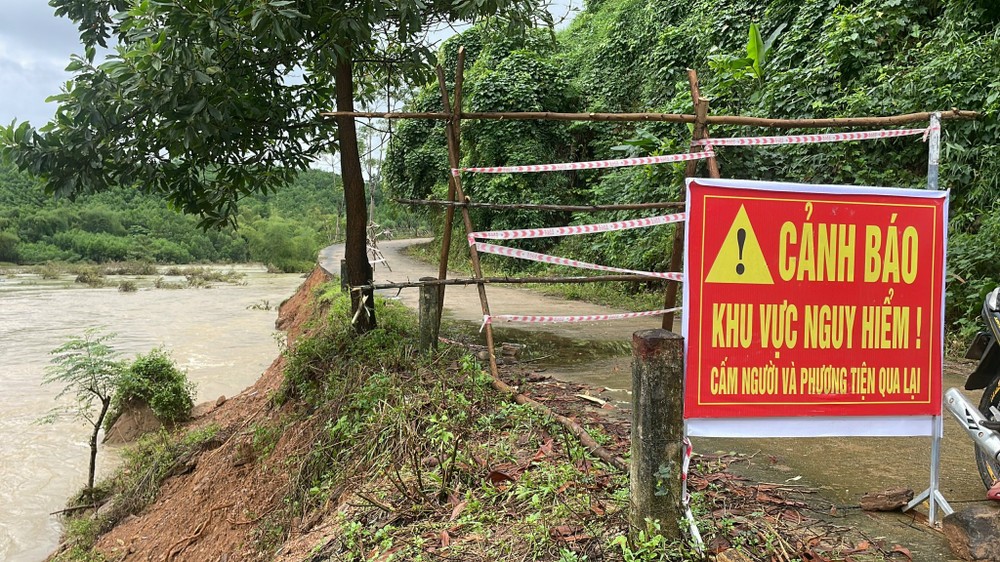
Districts in Kon Tum Province including Tu Mo Rong, Dak Glei, Kon Ray, and Kon Plong often experience landslides. For instance, there are 131 transport and irrigation works at risk of being affected by flash floods and landslides in Tu Mo Rong District and about 20 residential areas at risk of landslides, slope collapse, and flash floods.
The risk of landslides in Kon Ray District frequently occurred along the Dak Nhe River through Kon Skôi village in Dak Ruong Commune and residential areas along the Dak A Coi River in Dak Coi Commune, threatening the lives of hundreds inhabitants in the nearby area. Vice Chairman Nguyen Van Thuy of the Kon Ray District People's Committee said that the residential areas along the river above are located in the area of warning of the risk of insecurity during the flood season. The district has prepared a plan to evacuate people if flash floods occur.
Not only residents in the Central Highlands region but people in many areas in the Central provinces are also living in fear of landslides, especially during the rainy season and storms. Specifically, Quang Nam, Quang Ngai, Binh Dinh, Phu Yen, and Ha Tinh provinces have been heavily affected by natural disasters for many years, including landslides in riverside and mountain areas. Along the two banks of the Ha Thanh River through the communes of Canh Vinh, Canh Hien, and Canh Thuan in Binh Dinh Province’s Van Canh District, a series of serious riverbank erosion points were recorded. In many places, erosion has encroached deeply into rice fields and residential areas.
Chairman Tran Van Bai of Canh Vinh Commune People's Committee (Van Canh District) said that currently 8/9 communes of the commune are affected by the erosion along the Ha Thanh River. The extent of erosion is beyond the commune's intervention, so the local administration has no solution. Elsewhere in the Central region, Quang Ngai Province has made statistics that nearly 1,850 households (nearly 7,400 people) are living in areas with high risk of landslides, flash floods, and flash floods.
Even landslides have claimed the lives of innocent people. At the beginning of May, due to heavy rain, landslides in Hoanh Son Mountain in Ha Tinh Province killed three workers and injured four others who were working on the construction site of the 500kV transmission line project of the third phase.
Chairman Tran Pho Hue of Ky Lien Ward People's Committee (Ky Anh Town), said that the 500kV transmission line in the ward is constructed on high, steep, and precarious mountainous terrain, so they have the potential for landslides, especially during the rainy season and storms.
Lam Dong Province has three large passes connecting traffic between localities within the province itself and between Lam Dong and the Central Highlands provinces, and Ho Chi Minh City, namely Bao Loc Pass, Prenn Pass, and Sacom Pass. In previous years, the passes have continuously eroded and now, at the beginning of the rainy season, it has continued to erode. At Bao Loc pass, there are at least 12 erosion points that need to be handled promptly to ensure safety.
According to the Lam Dong Provincial People's Committee, currently, it has proposed to the Vietnam Directorate of Roads under the Ministry of Transport to soon approve investment projects to handle landslides on the pass. Although the Prenn Pass has just been upgraded and put into use since the beginning of 2024, landslides have also occurred; 15 three-leaf pine trees growing on the side of the pass were chopped down to eliminate the possibility of falling down the road. The risk of landslides still exists in the future.
At Sacom Pass, the local authorities are warning of the risk of landslides at Km2 +720 in Duc Trong District. Meanwhile, National Highway 40B plays an important role in connecting the two provinces of Kon Tum and Quang Nam. On the National Highway 40B is Mang Roi pass through Tu Mo Rong District of Kon Tum Province with a winding terrain. To reduce traffic through the pass, the locality has built a road to avoid Mang Roi pass. However, the current detour road is heavily eroded, with debris, rocks and soil on the road. On the positive side of the slope, large rocks and soil are waiting to slide, threatening drivers’ lives so none dares to travel through the detour road for fear of landslides but the winding pass.
Director Phan Muoi of the Kon Tum Provincial Department of Transport said that in addition to the Mang Roi pass detour road, many other important and main roads are also prone to landslides due to heavy rains, such as the Ho Chi Minh road through Dak Glei District, the National Highway 24 through Kon Plong District, the provincial Road 673 through Dak Glei District, the provincial Road 676 through Kon Plong District.
Because the terrain of Kon Tum Province is mountainous, and it is easy to cause landslides when it rains heavily for a long time.
Elsewhere in the South Central Province of Binh Thuan, after the first rain at the end of May, the main road leading to the Ham Tien - Mui Ne tourist area in Phan Thiet City has occurred two consecutive landslides due to red sand from high hills and real estate construction works flowing down, burying many people's property.
Not only roads, and rivers, but also railway tunnels are also eroded. The Bai Gio tunnel in Khanh Hoa Province and the Chi Thanh railway tunnel in Phu Yen Province respectively occurred landslides in April and May, disrupting traffic.
According to Deputy Minister of Transport Nguyen Danh Huy, the landslides of the Chi Thanh and Bai Gio railway tunnels are caused by many causes, including the complex geological conditions of the two tunnel areas, loose soil, and heavy rain for many days.




